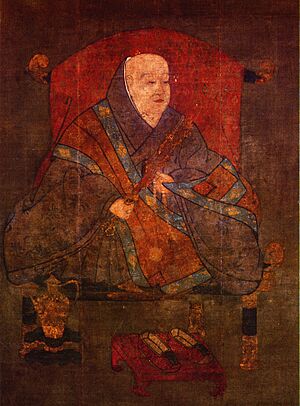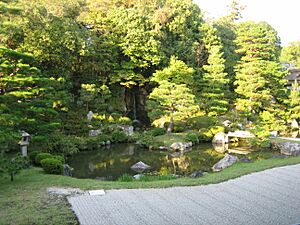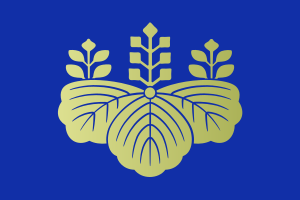Emperor Uda facts for kids
Quick facts for kids Emperor Uda宇多天皇 |
|||||
|---|---|---|---|---|---|
 |
|||||
| Emperor of Japan | |||||
| Reign | September 17, 887 – August 4, 897 | ||||
| Coronation | December 5, 887 | ||||
| Predecessor | Kōkō | ||||
| Successor | Daigo | ||||
| Born | June 10, 866 Heian Kyō (Kyōto) |
||||
| Died | September 3, 931 (aged 65) Buddhist temple of Ninna-ji (仁和寺) |
||||
| Burial | Ōuchiyama no misasagi (大内山陵) (Kyoto) | ||||
| Issue more... |
Emperor Daigo | ||||
|
|||||
| House | Yamato | ||||
| Father | Emperor Kōkō | ||||
| Mother | Hanshi | ||||
Emperor Uda (宇多天皇, Uda-tennō, June 10, 866 – September 3, 931) was the 59th emperor of Japan. He ruled from 887 to 897.
Contents
Emperor Uda's Life and Rule
Early Life and Family
Before he became emperor, his personal name was Sadami. He was the third son of Emperor Kōkō. His mother was Empress Dowager Hanshi. She was the daughter of Prince Nakano.
Emperor Uda had five main wives and 20 children. His most important sons were:
- Prince Atsuhito (884–930)
- Prince Atsuzane (893–967)
Becoming Emperor
Emperor Kōkō, Uda's father, had removed his sons from their royal titles. This was to save money and reduce their political power. Sadami was given the family name Minamoto.
In 887, Emperor Kōkō needed to choose his successor. Sadami was made a royal prince again. This happened with the help of Fujiwara no Mototsune, a powerful advisor. After his father died in November 887, Prince Sadami became Emperor Uda.
- September 17, 887: Emperor Kōkō passed away. His third son, Sadami, became the new emperor.
- December 5, 887: Mototsune, the powerful advisor, wanted to retire. But Emperor Uda asked him to stay. Uda said he was too young to rule alone. So, Mototsune continued to serve as the emperor's chief advisor.
Important Events During His Reign
Emperor Uda wanted to bring power back to the Imperial Family. He tried to reduce the strong influence of the Fujiwara family. This effort began after Mototsune died in 891.
- 888: The new Buddhist temple of Ninna-ji (仁和寺) was finished. A student of Kōbō-daishi became its first leader.
- 889: The former emperor Yōzei began to act strangely. He would be rude to people and sometimes disappear into the mountains.
Emperor Uda promoted officials who were not from the Fujiwara family. He especially trusted Sugawara no Michizane. Michizane quickly rose in rank and helped oversee the Crown Prince's household.
Emperor Uda also tried to improve how the government worked. He wanted to follow older rules and traditions. He encouraged the study of Confucian ideas.
- July 896: Emperor Uda sent Sugawara no Michizane to check on prisoners. He wanted to make sure no one was wrongly accused. He also gave a general pardon to some prisoners.
- Emperor Uda issued rules to protect farmers' land. He wanted to stop powerful families from taking their land. He also checked how taxes were collected in different areas.
Emperor Uda made a big decision: he stopped sending ambassadors to China. This was a practice that had gone on for a long time. He made this choice based on advice from Sugawara no Michizane.
The special festival of the Kamo Shrine was held for the first time during Uda's rule.
Abdication and Later Life
In 897, Emperor Uda decided to step down from the throne. He gave the throne to his oldest son, Prince Atsuhito. This son later became Emperor Daigo.
Uda wrote a special message for his son. It gave advice and guidance for ruling. He praised Fujiwara no Tokihira as an advisor but warned about his habits. He also praised Sugawara no Michizane as his teacher. Uda asked both of them to look after his son until he was older.
Three years later, in 900, Uda became a Buddhist priest at age 34. He made the temple at Ninna-ji his new home after leaving the throne. His Buddhist name was Kongō Kaku. He was sometimes called "the Cloistered Emperor of Teiji." This was because of the name of the Buddhist hall where he lived.
Emperor Uda died in 931 at the age of 65.
His burial place is known. He is honored at a Shinto shrine in Kyoto. The Imperial Household Agency calls this place Uda's mausoleum. It is formally named Kaguragaoka no Higashi no misasagi.
The former emperor is buried among the "Seven Imperial Tombs" at Ryōan-ji Temple in Kyoto. His burial mound is called O-uchiyama.
Important Officials (Kugyō)
Kugyō was a special term for the most powerful men in the emperor's court. This group usually had only three or four men at a time. They were experienced courtiers who had reached the highest levels of their careers.
During Emperor Uda's rule, some of these top officials included:
- Kampaku (Chief Advisor): Fujiwara no Mototsune (836–891)
- Daijō-daijin (Chancellor of the Realm): Fujiwara no Mototsune
- Sadaijin (Minister of the Left): Minamoto no Tōru, Fujiwara no Yoshiyo
- Udaijin (Minister of the Right): Minamoto no Masaru, Fujiwara no Yoshiyo, Minamoto no Yoshiari
Eras of Uda's Reign
The years of Emperor Uda's rule are known by these Japanese era names:
Family and Children
Emperor Uda had many children with his consorts and court ladies. Here are some of them:
- With Fujiwara no Onshi (daughter of Fujiwara no Mototsune):
- Imperial Princess Kinshi (890–910)
- With Fujiwara no Inshi (daughter of Fujiwara no Takafuji):
- Imperial Prince Atsugimi (885–930), who became Emperor Daigo
- Imperial Prince Atsuyoshi (887–930)
- Imperial Princess Jūshi (892–958), who served at Ise Shrine
- With Tachibana no Yoshiko/Gishi (daughter of Tachibana no Hiromi):
- Imperial Prince Tokinaka (885–891)
- Imperial Prince Tokiyo (886–927), later a priest
- Imperial Princess Kunshi (died 902), who served at Kamo Shrine
- With Sugawara no Hiroko/Enshi (daughter of Sugawara no Michizane):
- Minamoto no Junshi (875–925)
- With Fujiwara no Hōshi (daughter of Fujiwara no Tokihira):
- Imperial Prince Masaakira (920–929)
- Imperial Prince Yukiakira (926–948)
See also
 In Spanish: Uda Tennō para niños
In Spanish: Uda Tennō para niños
- Emperor of Japan
- List of Emperors of Japan
- Imperial cult
- Emperor Go-Uda
| Regnal titles | ||
|---|---|---|
| Preceded by Emperor Kōkō |
Emperor of Japan: Uda 887–897 |
Succeeded by Emperor Daigo |



